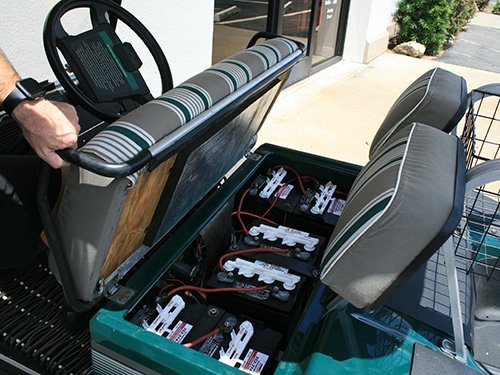Golf cart batteries, also known as deep-cycle batteries, have specific requirements to ensure optimal performance and longevity in the context of golf cart applications. Here are some key requirements for golf cart batteries.
- Voltage:
- Golf carts typically use batteries with a voltage of 36 volts or 48 volts. The batteries are configured in series to achieve the desired voltage.
- Deep-Cycle Design:
- Golf cart batteries need to be deep-cycle batteries designed to withstand repeated deep discharges and recharges. They are different from automotive batteries, which are generally starting batteries designed for short bursts of high current.
- Capacity (Ampere-Hour Rating):
- The capacity of golf cart batteries is measured in ampere-hours (Ah). Higher capacity batteries provide longer runtimes between charges. Common capacities for golf cart batteries range from 150Ah to 250Ah.
- Battery Type:
- Lead-acid batteries, particularly flooded lead-acid batteries and more specifically, deep-cycle lead-acid batteries, are commonly used in golf cart applications. Absorbent Glass Mat (AGM) and gel batteries are also options, offering maintenance-free operation and better resistance to vibration.
- Maintenance:
- Golf cart batteries may be either maintenance-free (sealed) or require periodic maintenance, such as adding distilled water to flooded lead-acid batteries. Maintenance-free batteries are often preferred for ease of use.
- Size and Dimensions:
- Golf cart batteries come in various sizes and form factors. It’s essential to choose batteries that fit the designated battery compartment in the golf cart.
- Durability and Vibration Resistance:
- Golf cart batteries should be designed to withstand the vibrations and shocks associated with driving a golf cart over various terrains.
- Charging Efficiency:
- The batteries should have good charging efficiency to ensure that they can be charged effectively during regular charging cycles.
- Cyclic Performance:
- Golf cart batteries need to have a high number of charge-discharge cycles to accommodate the frequent use and deep cycling typical of golf cart applications.
- Operating Temperature Range:
- The batteries should operate within a specified temperature range to ensure optimal performance. Extreme temperatures, both hot and cold, can affect battery performance.
- Compatibility with Charger:
- Ensure that the golf cart battery is compatible with the charger used to recharge it. Different types of batteries (flooded lead-acid, AGM, gel) may have specific charging requirements.
- Warranty:
- Consider the warranty provided by the battery manufacturer. A longer warranty period often indicates the manufacturer’s confidence in the battery’s quality and performance.
When selecting golf cart batteries, it’s crucial to refer to the manufacturer’s recommendations and specifications for the specific make and model of the golf cart. Regular maintenance, proper charging practices, and adherence to manufacturer guidelines contribute to the longevity and reliable performance of golf cart batteries.


